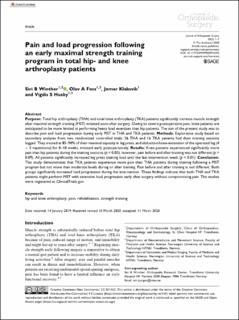| dc.contributor.author | Winther, Siri B | |
| dc.contributor.author | Foss, Olav | |
| dc.contributor.author | Klaksvik, Jomar | |
| dc.contributor.author | Husby, Vigdis S | |
| dc.date.accessioned | 2020-05-22T07:25:13Z | |
| dc.date.available | 2020-05-22T07:25:13Z | |
| dc.date.created | 2020-05-11T13:54:44Z | |
| dc.date.issued | 2020 | |
| dc.identifier.issn | 1022-5536 | |
| dc.identifier.uri | https://hdl.handle.net/11250/2655257 | |
| dc.description.abstract | Purpose:
Total hip arthroplasty (THA) and total knee arthroplasty (TKA) patients significantly increase muscle strength after maximal strength training (MST) initiated soon after surgery. Owing to severe postoperative pain, knee patients are anticipated to be more limited in performing heavy load exercises than hip patients. The aim of the present study was to describe pain and load progression during early MST in THA and TKA patients.
Methods:
Explorative study based on secondary analyses from two randomized controlled trials: 26 THA and 16 TKA patients had their training sessions logged. They trained at 85–90% of their maximal capacity in leg press, and abduction/knee-extension of the operated leg (4 × 5 repetitions) for 8–10 weeks, initiated early postoperatively.
Results:
Knee patients experienced significantly more pain than hip patients during the training sessions (p < 0.03), however, pain before and after training was not different (p > 0.09). All patients significantly increased leg press training load until the last intervention week (p < 0.01).
Conclusion:
This study demonstrates that TKA patients experience more pain than THA patients during training following a MST program but not more than moderate levels during or after training. Pain before and after training is not different. Both groups significantly increased load progression during the intervention. These findings indicate that both THA and TKA patients might perform MST with extensive load progression early after surgery without compromising pain. The studies were registered at ClinicalTrials.gov. | en_US |
| dc.language.iso | eng | en_US |
| dc.publisher | SAGE Publications | en_US |
| dc.rights | Navngivelse-Ikkekommersiell 4.0 Internasjonal | * |
| dc.rights.uri | http://creativecommons.org/licenses/by-nc/4.0/deed.no | * |
| dc.title | Pain and load progression following an early maximal strength training program in total hip- and knee arthroplasty patients. | en_US |
| dc.type | Peer reviewed | en_US |
| dc.type | Journal article | en_US |
| dc.description.version | publishedVersion | en_US |
| dc.source.volume | 28 | en_US |
| dc.source.journal | Journal of Orthopaedic Surgery | en_US |
| dc.source.issue | 2 | en_US |
| dc.identifier.doi | 10.1177/2309499020916392 | |
| dc.identifier.cristin | 1810308 | |
| dc.description.localcode | (C) The Author(s) 2020. This article is distributed under the terms of the Creative Commons Attribution-NonCommercial 4.0 License (https://creativecommons.org/licenses/by-nc/4.0/) which permits non-commercial use, reproduction and distribution of the work without further permission provided the original work is attributed as specified on the SAGE and Open Access pages (https://us.sagepub.com/en-us/nam/open-access-at-sage). | en_US |
| cristin.ispublished | true | |
| cristin.fulltext | original | |
| cristin.qualitycode | 1 | |

